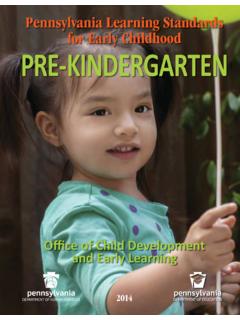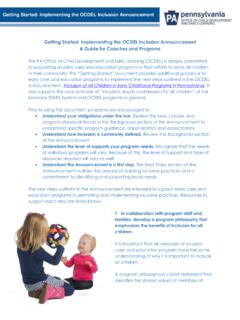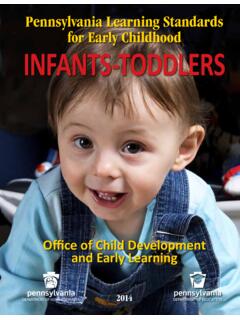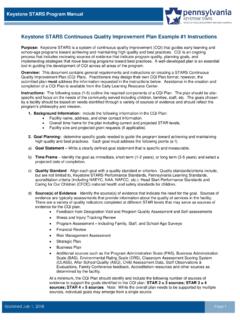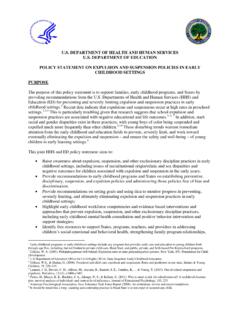Transcription of Early Childhood Assessment For Children From Birth to Age
1 Early Childhood Assessment FOR Children FROM Birth TO AGE 8 (Grade 3) December 2005 Early Learning Standards Task Force and Kindergarten Assessment Work Group Pennsylvania BUILD Initiative Pennsylvania s Departments of education and Public Welfare Harrisburg, PA Pennsylvania Standards for Learning Assessment & Curriculum December, 2005 3 Early Childhood Assessment FOR Children FROM Birth TO AGE 8 (Grade 3) I. Introduction 5 II. Measuring Children s Development and Learning 6 III.
2 Curriculum 15 IV. Linking Assessment And Curriculum 17 V. Conclusion 18 VI. Resources For Measuring Classroom Environments 18 VII. References 20 VIII. Assessment Tools 24 IX. Curriculum Resources 35 X.
3 Workgroup Members 36 XI. Definitions 37 Pennsylvania Standards for Learning Assessment & Curriculum December, 2005 4 Pennsylvania Standards for Learning Assessment & Curriculum December, 2005 5 Early Childhood Assessment FOR Children FROM Birth TO AGE 8 (Grade 3) I. INTRODUCTION Developmental assessments are a process which allows one to understand a child s competencies and to design learning environments which will help a child grow to his or her developmental potential whether this is from Birth to age 8 or third grade.
4 Assessments that are implemented in the classroom and aligned with Pennsylvania s standards for learning ( Birth to age 8 or third grade) will help inform teachers about designing a curriculum that provides multiple learning opportunities that best suits how each child learns. A two step process occurred to provide guidance to Early Childhood programs and school districts for the alignment of Assessment and curriculum to the Pennsylvania standards for learning for Children Birth to age 8. First, a workgroup consistently mostly of members of the original Early Learning Standards Taskforce was formed.
5 This workgroup developed a report, Final Report and Guidelines on Assessment and Curriculum (2005) to address the linkages of Assessment and curriculum that would assist in the adherence to the Early Learning Standards for Pre-Kindergarten Children . An important workgroup goal was to help make program personnel aware of available materials that encourage teachers to rely on authentic measures of Early learning and development that link directly to program content and goals, as well as Pennsylvania s standards for learning, and that sample skills in natural, active learning environments, rather than contrived circumstances.
6 The second step in the process to provide guidance for Pennsylvania s standards for learning was to convene a second work group comprised of individuals from the Pennsylvania Department of education , school districts, universities, Early Childhood , and Early intervention to examine the original document developed by the Early Learning Standards Taskforce. The intent of the meeting was to examine the report and to determine how to modify it so that the report emphasized that Assessment and curriculum are part of a continuum that begins at Birth and extends through Kindergarten to third grade.
7 The information provided in this document incorporates information from the original report and it also emphasizes the importance of viewing Assessment and curriculum development as a continuous process from Birth to age 8. Therefore, the current Assessment guidance document meets the needs of both the Early Learning Standards and the Kindergarten Standards. This report offers information about the extent to which several Assessment tools and curriculum materials align with Pennsylvania s standards for learning ( Birth to age 8). It is not the Department of education s intention to make specific recommendations with regard to the items on the lists provided herein (see Tables Pennsylvania Standards for Learning Assessment & Curriculum December, 2005 61-3), rather, the Department wishes to provide guidelines for decision making that would best adhere to the Pennsylvania standards for learning ( Birth to age 8).
8 Given the many resources available on the market, both workgroups limited the list of Assessment tools to those that are evidence-based and have demonstrated technological adequacy for the preschool and elementary school age groups. The list of Assessment tools also focuses specifically on Assessment for the purpose of informing instruction; thus, the measures are all appropriate and feasible for administration by teachers and other classroom personnel. It is important to realize that there are many purposes of Assessment , such as for diagnostic purposes, for program evaluation, for determining school readiness, and for screening developmental delays or learning difficulties.
9 These other purposes are not as relevant for adhering to the Pennsylvania standards for learning ( Birth to age 8) and so the focus of this report is on using Assessment to inform instruction. Summary of Tables: There is a brief overview of critical features (see Tables 1 through 3) for each instrument. These tables are appropriate for both the Early Learning Standards and the Kindergarten standards and the instruments are marked accordingly. Next, we offer an overview of the coverage ( , alignment) of the Key Learning Areas of the Early Learning Standards for Pre-Kindergarten for each of the measures (see Tables 4 and 5).
10 Blank cells in the table represent the Key Learning Areas that are not covered by that instrument. An X indicates that there is at least minimal coverage of that key learning area. An overview for the Kindergarten Standards will be added in the future. For more specific details within each of the Key Learning Areas, one needs to refer to the extensive matrices in which items from each of the instruments are correlated with the Standards at the Indicator level. Table 6 provides an overview of the coverage of curriculum materials for each of the Key Learning Areas in the Early Learning Standards.


